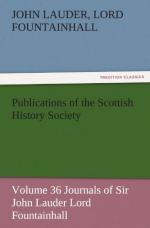and the formation of institutions—what they
should call constitutional history. There had
been a school of historical writers of late who
would almost confine history to that record—nothing
else was proper history, and the consequence was that
the constitution of history was in the publication
of documents and in the changes in the manner of
government. That was an essential and a very
important part of history, but by itself it would be
a very dreich kind of history. History was
the authentic record of whatever happened in the
world, and Scottish history of whatever had happened
in the Scottish world. If he had been told
that on a certain date King James V., the Red Fox,
rode over Cramond Bridge with five horsemen, one of
them on a white horse, they might say what use was
it to him to know that, but he did want to know
it and have that picture in his mind. It was
a piece of history, and any one who was bereft of interest
in that sort of thing—however little
use it might be turned to—was bereft of
the historical faculty. Then there was a conception
of history that it should consist in pictures of
the generation, of the people, how they were housed,
how they were fed, and so on. That was a capital
notion. But he was not sure that there were
not certain overdoings of that notion. In the
first place, they would observe that they must take
a succession of generations in order to accomplish
that descriptive history of the state of Scotland
at one time, then at another, then at a third, and
so on. A description at one time would not apply
to the society of Scotland at another.
’Quhan Alysander, oure
Kyng, was deid,
Quhan Scotland led in luve
and le,
Awa’ wes sons of ail
and brede,
Of wyne and wax, of gamyn
and glee.’
That was to say, it was a tradition before that time that there was abundance and even luxury in Scotland. There had been a tendency in history of late to dwell on the poverty and squalor of Scotland in comparison with other countries—all that should be produced, and made perfectly conceivable—and then also to dwell on the records of kirk- sessions and presbyteries, showing the state of morality in Scotland. All that it was desirable should be produced in abundance if they were not wrongly construed—but they were apt to be. A notion had arisen what a comical country Scotland must have been with its Shorter Catechism, and its presbytery records, and its miserable food, and so on. That was a wrong notion, and ought to be dismissed, because if they thought of it the life of a community consisted in how it felt, how it acted. In those days of poverty and squalor of external surroundings there were as good men, as brave men, and as good women as there were in Scotland now. And at all events, if there was anything in Scotland now, any power in the world, it had sprung from these progenitors. They must have some corrective for an exaggeration of that notion, which was very




